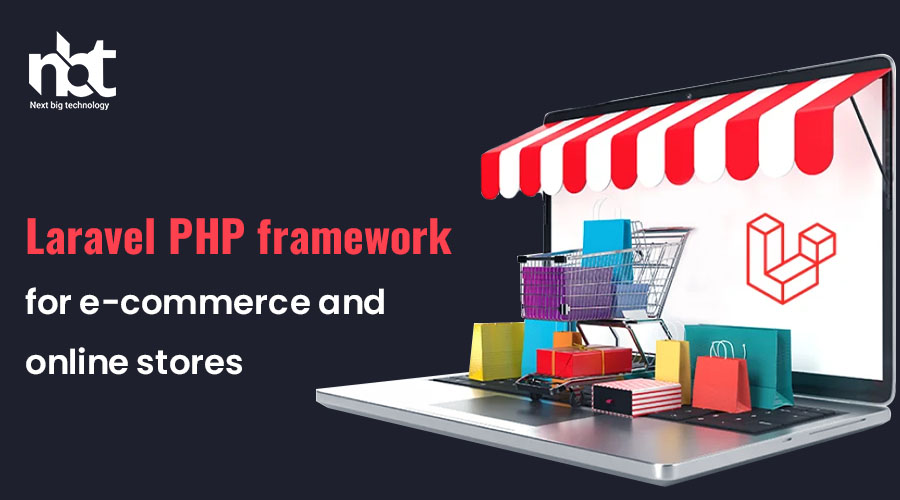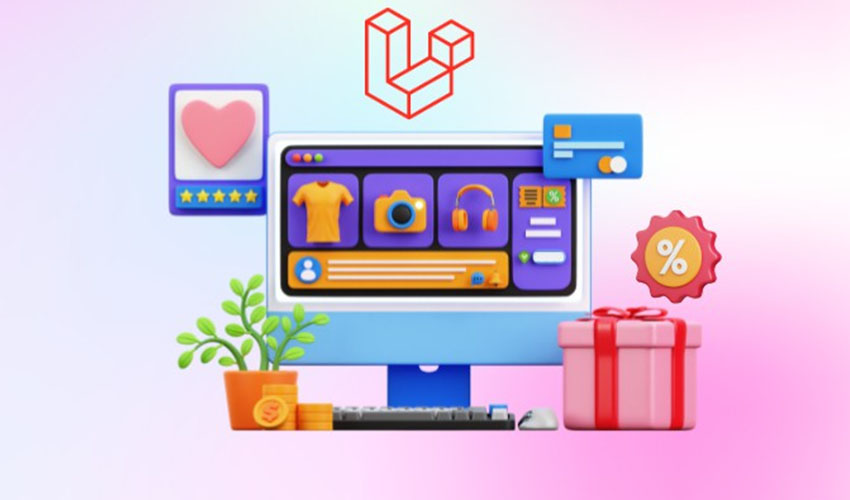Table of Contents
Introduction to Laravel for E-commerce
In the bustling realm of e-commerce, the technology that underpins an online store plays a pivotal role in its success. Among the plethora of options available, Laravel, a PHP framework, has emerged as a beacon of innovation and efficiency for crafting robust and scalable e-commerce platforms. Designed with a focus on elegance, simplicity, and developer-friendly features, Laravel has revolutionized the landscape of web development, offering a comprehensive toolkit perfectly suited for the dynamic requirements of e-commerce ventures.
Evolution of Laravel: A Brief History
Born in 2011, Laravel was conceived by Taylor Otwell as an attempt to create a more advanced and expressive alternative to existing PHP frameworks. Its journey commenced with a vision to simplify common tasks encountered in web development while promoting best practices and developer convenience. Through meticulous design and consistent enhancements, Laravel has evolved into a mature and sophisticated framework revered for its flexibility and versatility, especially in the realm of e-commerce.
Understanding Laravel’s Core Principles
At the heart of Laravel lies a set of core principles that define its functionality and allure for e-commerce development:
Eloquent ORM: Streamlining Database Interactions
Laravel’s Eloquent ORM (Object-Relational Mapping) simplifies database interactions by providing an intuitive and expressive syntax for working with databases. This eloquent approach facilitates seamless data manipulation, allowing developers to create, retrieve, update, and delete data using PHP syntax rather than complex SQL queries.
Blade Templating Engine: Simplifying UI Development
The Blade templating engine empowers developers to create elegant and reusable templates, significantly reducing the complexity of designing user interfaces for e-commerce platforms. Its intuitive syntax and support for template inheritance facilitate the creation of dynamic and visually appealing storefronts and user experiences.
Laravel’s Ecosystem: A Wealth of Features and Libraries
Laravel boasts an extensive ecosystem comprising various libraries, pre-built components, and third-party integrations. For e-commerce ventures, this ecosystem translates into accelerated development of essential functionalities such as shopping carts, payment gateways, inventory management systems, and more, significantly reducing development time and effort.
Tailoring Laravel for E-commerce Success
Laravel’s adaptability and extensibility make it an ideal choice for crafting custom e-commerce solutions that cater specifically to the unique requirements of online stores:
Modular Architecture: Building Blocks of Innovation
The modular architecture of Laravel facilitates the creation of modular components, enabling developers to construct e-commerce platforms by piecing together reusable and interchangeable modules. This modular approach enhances flexibility, scalability, and maintainability, allowing for seamless integration of new features and functionalities.
Security Fortification: Safeguarding Transactions
Security remains a paramount concern in e-commerce, and Laravel addresses this concern comprehensively. The framework integrates robust security measures, including protection against SQL injection, cross-site request forgery, cross-site scripting, and more. Additionally, Laravel’s authentication and authorization mechanisms ensure secure access control, safeguarding sensitive user data and transactions.
Scalability and Performance Optimization
As an e-commerce platform grows, scalability becomes imperative. Laravel’s architecture is designed to handle scalability challenges effectively. Its efficient caching mechanisms, database optimization tools, and task scheduling capabilities ensure optimal performance, allowing online stores to accommodate increasing traffic and transactions seamlessly.
Future Prospects and Community Support
The success and relevance of any framework in the tech landscape are often tied to its community support and future prospects. Laravel enjoys a vibrant and active community of developers and contributors, constantly enriching its ecosystem with updates, enhancements, and best practices. This collaborative effort ensures that Laravel remains at the forefront of technological advancements, providing e-commerce platforms with a future-proof foundation for innovation and growth.
Key Advantages of Using Laravel for E-commerce
In the realm of e-commerce, selecting the right framework lays the foundation for a successful online store. Laravel, a robust PHP framework, has garnered attention for its exceptional features and functionalities perfectly tailored for the demands of e-commerce ventures. Let’s delve into the key advantages that make Laravel a preferred choice for crafting efficient, secure, and scalable e-commerce platforms.
1. Efficient Development Process:
Laravel’s elegant and expressive syntax significantly streamlines the development process for e-commerce platforms. Its MVC (Model-View-Controller) architecture provides a clear separation of concerns, allowing developers to work on different aspects concurrently. The framework’s artisan command-line tool automates repetitive tasks, reducing development time and boosting productivity.
The use of Eloquent ORM simplifies database interactions, enabling seamless management and manipulation of data. This feature becomes invaluable in e-commerce, where handling product information, customer data, and transaction records efficiently is paramount.
2. Customization and Flexibility:
E-commerce platforms demand customization to align with unique business requirements. Laravel’s modular structure empowers developers to create tailored solutions by integrating specific components and functionalities seamlessly. With its extensive libraries and pre-built modules, developers can swiftly implement essential e-commerce features like shopping carts, inventory management systems, and secure payment gateways, ensuring a personalized user experience.
3. Security Fortification:
Security breaches can be catastrophic for e-commerce ventures, compromising sensitive customer information and eroding trust. Laravel takes a proactive stance on security, offering built-in features to mitigate common vulnerabilities like SQL injection, cross-site scripting, and cross-site request forgery. Its robust authentication and authorization mechanisms bolster platform security, ensuring a safe environment for online transactions and safeguarding customer data.
4. Scalability and Performance Optimization:
E-commerce platforms must accommodate growing traffic and transactions without compromising performance. Laravel’s scalability features, including efficient caching mechanisms and task scheduling capabilities, ensure that platforms can scale seamlessly. Additionally, optimization tools provided by Laravel enhance performance, delivering a responsive and seamless user experience even during high traffic periods.
5. SEO-Friendly Architecture:
Visibility in search engines is pivotal for driving organic traffic to e-commerce platforms. Laravel’s clean and semantic codebase facilitates the implementation of SEO best practices. Developers can easily optimize metadata, URLs, and content, enhancing the platform’s search engine ranking. This SEO-friendly architecture contributes to increased visibility and attracts potential customers to the online store.
6. Community Support and Continuous Improvement:
Laravel benefits from a thriving community of developers who actively contribute to its ecosystem. Regular updates, bug fixes, and enhancements ensure that e-commerce platforms built on Laravel remain technologically relevant. The robust community support also provides access to a plethora of resources, tutorials, and plugins, empowering developers to resolve issues efficiently and stay abreast of industry trends.
Customizing E-commerce Solutions with Laravel
In the realm of online commerce, adaptability reigns supreme. As businesses strive to carve their niche in the digital landscape, the need for customizable and scalable e-commerce solutions becomes increasingly imperative. Laravel, the versatile PHP framework, stands out as a potent tool in the arsenal of developers, offering a myriad of opportunities for tailoring e-commerce platforms to meet unique business requirements. Within this expansive landscape, let’s delve into the world of customizing e-commerce solutions with Laravel.
Understanding Laravel’s Foundation for Customization
At its core, Laravel provides a robust foundation that lends itself to extensive customization. Its modular architecture and expressive syntax empower developers to seamlessly extend and adapt functionalities to suit specific e-commerce needs. The framework’s adherence to the Model-View-Controller (MVC) architecture simplifies the separation of concerns, facilitating the customization process without compromising the system’s integrity.
Leveraging Eloquent ORM for Data Flexibility
Laravel’s Eloquent Object-Relational Mapping (ORM) system stands as a cornerstone for customizing e-commerce solutions. It enables developers to interact with databases using PHP syntax, allowing for agile data manipulation and seamless integration of complex business logic. This flexibility allows for the creation of tailored database structures that align precisely with the unique requirements of diverse e-commerce models.
Crafting Tailored User Experiences
E-commerce success hinges on user experience. Laravel empowers developers to craft highly personalized and intuitive interfaces for online stores. Through Blade templating, Laravel’s robust templating engine, developers can create dynamic and responsive front-end experiences that resonate with the brand identity and meet the specific needs of diverse customer segments.
Extending Functionalities with Packages and Libraries
Laravel’s ecosystem boasts a rich repository of packages and libraries, simplifying the process of extending e-commerce functionalities. Developers can leverage these readily available tools to integrate payment gateways, implement shipping solutions, manage inventory, and enhance security features seamlessly. These packages serve as building blocks, accelerating the development process while ensuring scalability and reliability.
Tailoring Payment Gateways and Checkout Processes
The checkout process stands as a pivotal phase in the e-commerce journey. With Laravel, customizing payment gateways and checkout processes becomes an agile task. The framework’s flexibility enables the integration of various payment gateways, ensuring a smooth and secure transaction experience for customers. Custom checkout processes tailored to specific business requirements can be implemented seamlessly, optimizing conversions and user satisfaction.
Implementing Scalable Inventory Management Systems
Efficient inventory management is crucial for the seamless operation of e-commerce platforms. Laravel’s extensibility allows developers to design and implement scalable inventory management systems tailored to the unique demands of diverse businesses. Real-time updates, stock tracking, and automated alerts can be integrated seamlessly, ensuring optimal inventory control and streamlined operations.
Security Customizations and Best Practices
The integrity and security of e-commerce platforms are paramount. Laravel’s robust security features, coupled with the ability to implement custom security measures, empower developers to fortify online stores against potential threats. Custom encryption, data validation, role-based access control, and protection against common vulnerabilities like SQL injection and cross-site scripting can be seamlessly integrated.
Harnessing Laravel’s Community and Future-Proofing Capabilities
Laravel’s thriving community of developers serves as an invaluable resource for customizing e-commerce solutions. Continuous updates, community-driven enhancements, and shared expertise ensure that Laravel-based e-commerce platforms remain technologically relevant and future-proof. Collaboration within the community fosters innovation, offering insights and solutions to tackle evolving challenges in the e-commerce landscape.





















